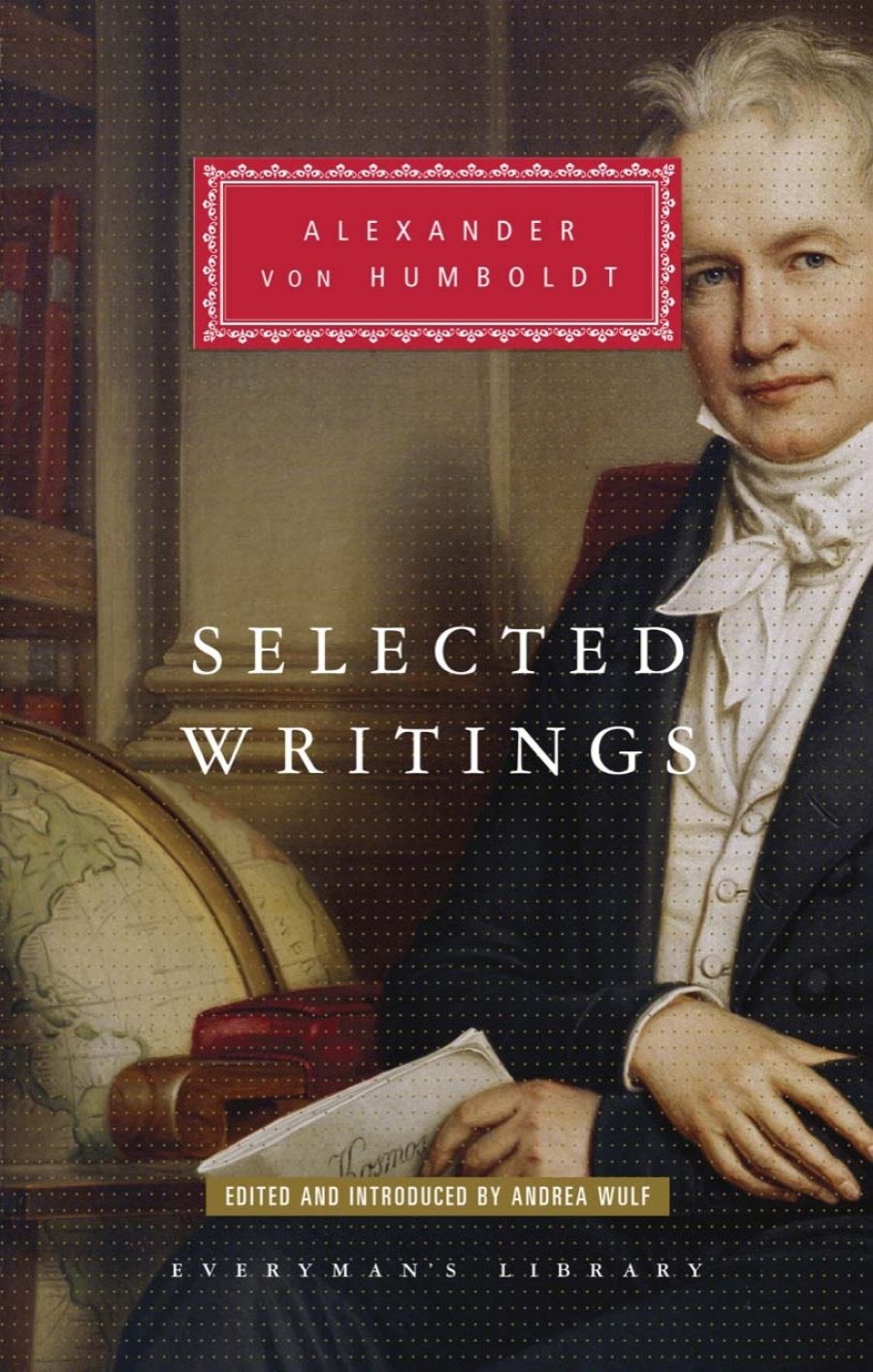
- Free Article: No
- Contents Category: Essay Collection
- Review Article: Yes
- Online Only: No
- Custom Highlight Text:
It can be revelatory to read the original words of a famous writer and thus meet them on the page. Alexander von Humboldt (1769–1859) has been so much quoted and written about that it might be rare even for his admirers to be exposed to his original prose at length and in context. It is a rewarding experience, especially when the writer cared so much for the ‘melody’ of his sentences ...
- Grid Image (300px * 250px):

- Alt Tag (Grid Image): Alexander von Humboldt
- Book 1 Title: Alexander von Humboldt: Selected writings
- Book 1 Biblio: Everyman, $49.95 hb, 792 pp, 9781101908075
It was the Personal Narrative of these travels (in seven volumes) that Darwin kept on a little shelf next to his hammock on the HMS Beagle; he knew them almost by heart. His predecessor’s fresh descriptions and intellectual excitement helped Darwin make his own voyage a life-changing experience that would seed a scientific revolution. It is appropriate that almost half of this anthology is devoted to selections from this gripping expedition narrative.
The height of Humboldt’s expedition in every sense was in 1802: the climbing of Chimborazo, a dormant stratovolcano in the Andes. At almost 21,000 feet, it was then thought to be the highest mountain in the world. The experience of the climb crystallised Humboldt’s understanding of nature: he observed plants distributed according to location and climate; at his feet, he saw a unified Earth, a systematic cosmos of life. At the base of the volcano, Humboldt began to sketch his vision, and the resulting Essay on the Geography of Plants is the second text anthologised in this volume. It has at its heart a ‘tableau’ or engraving depicting Chimborazo in cross-section and showing the distribution of plants from the valley to the snowline, accompanied by readings of gravity, temperature, air chemistry, barometric pressure, humidity, the temperature of boiling water, and other careful measurements. In this single graphic, Humboldt aimed to summarise ‘almost the entirety of the research I carried out during my expedition in the tropics’. Goethe ‘devoured’ the Essay when he received it in March 1807 and immediately reread it several times, declaring Humboldt had lit science into a ‘bright flame’.
The third set of passages are drawn from Humboldt’s own favourite of his books, Views of Nature, a tour de force of nature writing created during a difficult time for the scientist. Writing the book enabled him to escape into his travels, where he reinhabited ‘the glowing womb of the earth’. He vividly evoked the animal uproar of the nocturnal rainforest, a sensuous, raucous vision of competing, questing, abundant nature. Writing in 1808, he spoke of ‘the gradual transformation of species’.
 Portrait of Alexander von Humboldt, 1843, by Joseph Karl Stieler (photograph via Wikimedia Commons)
Portrait of Alexander von Humboldt, 1843, by Joseph Karl Stieler (photograph via Wikimedia Commons)
The next two selected texts are Views of the Cordilleras and Monuments of the Indigenous Peoples of the Americas, which in its original form contained sixty-nine engravings, and Political Essay on the Island of Cuba. They reveal Humboldt’s deep engagement with the human world. He was fascinated by the ancient civilisations of Latin America and their sophisticated cultures, languages, architecture, and art. His essay on Cuba is notable for his detestation of slavery, which he called ‘possibly the greatest evil to have afflicted humanity’. Wulf reminds us that when a US edition of this book left out Humboldt’s criticism of slavery, he issued a press release to newspapers denouncing it – and emphasised that the deleted sections were the most important in the book.
The anthology concludes with Cosmos, Humboldt’s final and most famous book and an instant bestseller. This Sketch of a Physical Description of the Universe took his readers from outer space to Earth to microscopic organisms, from stars to volcanoes to art; it was about nature in all its majesty and intricacy, about human history from ancient civilisations to modern times, and about feelings, aesthetics, poetry, and the imagination. He evoked a ‘wonderful web of organic life’. This enthusiastic measurer of everything knew that ultimately, ‘What speaks to the soul escapes our measurements.’
Wulf confesses that selecting writings from the vast work of such a prolific author was not easy, but she has succeeded in preserving the breadth of his thinking and the power of his prose. She concludes her introduction by celebrating Humboldt as ‘the link between the arts and the sciences; between the Enlightenment and the poetry of the Romantics’. Many readers will be prompted to revisit Wulf’s marvellous biography, The Invention of Nature, published in 2015. But nothing quite brings Humboldt to life like his own words – and they resound with new meaning today.


Comments powered by CComment